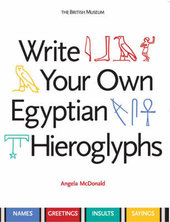
|
Write Your Own Egyptian Hieroglyphs: Names * Greetings * Insults * Sayings
Paperback / softback
Main Details
| Title |
Write Your Own Egyptian Hieroglyphs: Names * Greetings * Insults * Sayings
|
| Authors and Contributors |
By (author) Angela McDonald
|
| Physical Properties |
| Format:Paperback / softback | | Pages:64 | | Dimensions(mm): Height 260,Width 200 |
|
| Category/Genre | History of writing
Genealogy, heraldry, names and honours |
|---|
| ISBN/Barcode |
9780714119762
|
| Classifications | Dewey:493.111 |
|---|
| Audience | |
|---|
| Illustrations |
Illustrated in colour and black and white throughout
|
|
Publishing Details |
| Publisher |
British Museum Press
|
| Imprint |
British Museum Press
|
| Publication Date |
14 May 2007 |
| Publication Country |
United Kingdom
|
Description
A handy and colourful illustrated guide to reading, writing and understanding ancient Egyptian names, epithets, titles and phrases. The Egyptians believed that the creator god Ptah brought the world into being by naming everything in it. Names had great power, and kings often over-wrote their own names on monuments of earlier rulers. A person's name was a vitally important part of them, and the Egyptians were very concerned that their names should be recorded, remembered and spoken. Criminals and those who had fallen out of favour could be punished - wiped out of history - by having their names destroyed or defaced. The hieroglyphic script provided a beautiful, flexible and expressive meaning to write the names of humans, gods and animals. Angela McDonald explains the meanings of Egyptian personal names and how they were made up (Rameses = "Ra has given birth to him"), and demonstrates how they were written in different ways to convey various shades of meaning. Royal and divine names are always given special treatment. The Egyptians were not always formal, and nicknames were common. Even the names of pet animals are recorded in tomb paintings.
Author Biography
Angela McDonald lectures in Egyptology at Glasgow University. She has previously taught at Oxford University and at Liverpool University.
|